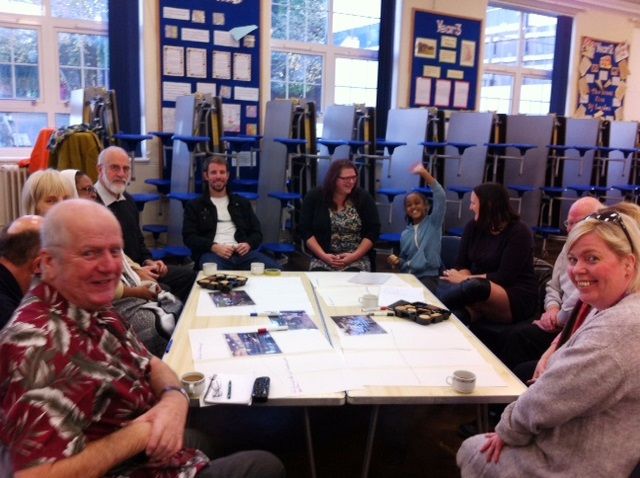
Touchstone Six: Visioning and Planning
Getting to a place where a community can grow and share a plan is a complex dynamic process, that at least in part can be thought of as a process of support an association of associations to get into a possibility conversation, followed by a commitment conversation. Scott Peck reminds us that closed communities that do not welcome strangers are in fact not communities at all. They are the opposite: cliques.
If a community is to prevail its citizens must cultivate the capacity not just to associate with each other, but also to grow a sharing economy, to celebrate cultural diversity, to live within ecological boundaries and honour place. These dynamics and the ever-flowing connections that birth them, yield a commonwealth and collective power that are critical determinants of well-being, wisdom, justice, safety and prosperity.
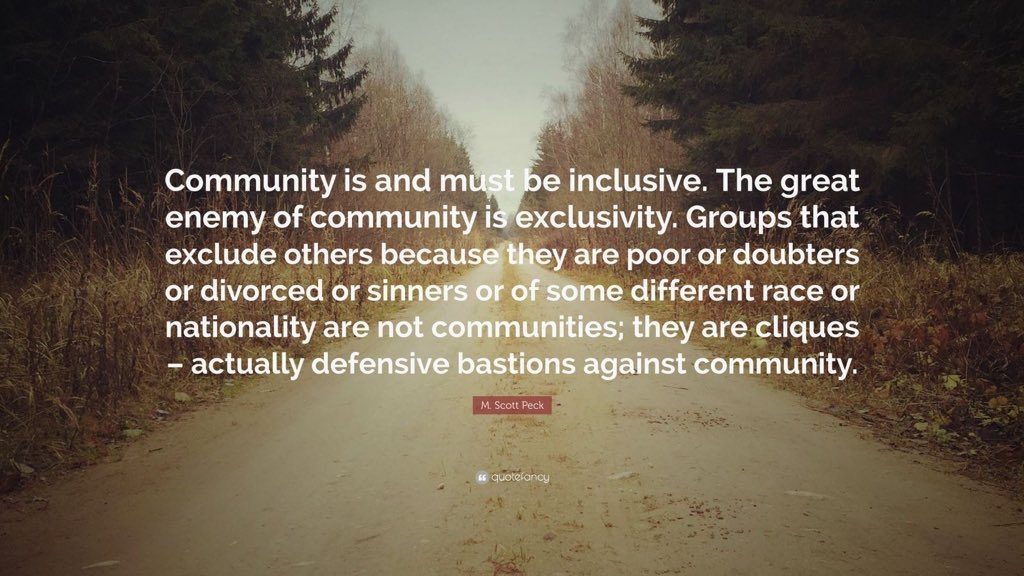 When we stop treating individuals as problems to be fixed, and conceiving of institutions as having a monopoly on all the best solutions to said problems, it becomes easier to see the majesty and productivity of communities. And when we look to understand how people grow and produce power, prosperity, wellness, and justice and what they use to do so, we will more clearly see and understand community assets. The diagram below presents the Neighbourhood as a unit of change, like an ecosystem (as Paul Wright described last week). Here people, economy, cultures and ecology are in an endless interactive dance and it is on these foundations that people can vision a better shared future and commit to making it visible.
When we stop treating individuals as problems to be fixed, and conceiving of institutions as having a monopoly on all the best solutions to said problems, it becomes easier to see the majesty and productivity of communities. And when we look to understand how people grow and produce power, prosperity, wellness, and justice and what they use to do so, we will more clearly see and understand community assets. The diagram below presents the Neighbourhood as a unit of change, like an ecosystem (as Paul Wright described last week). Here people, economy, cultures and ecology are in an endless interactive dance and it is on these foundations that people can vision a better shared future and commit to making it visible.
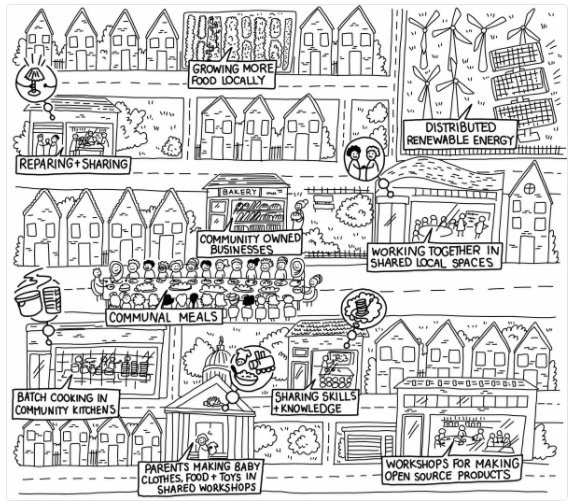 The reason is simple but profound: it takes a village to produce health, justice, safety and prosperity. And while I know that a community is not sufficient to solve all the world’s problems, I also know it is essential in getting to the root of most if not all socio-economic challenges. Margaret Wheatley suggests that: “whatever your issue, community is the answer”. I would suggest modifying that slightly to say: “whatever the issue, community is an essential part of the answer”.
The reason is simple but profound: it takes a village to produce health, justice, safety and prosperity. And while I know that a community is not sufficient to solve all the world’s problems, I also know it is essential in getting to the root of most if not all socio-economic challenges. Margaret Wheatley suggests that: “whatever your issue, community is the answer”. I would suggest modifying that slightly to say: “whatever the issue, community is an essential part of the answer”.
Take public safety as a case in point, though many people may be of the view that it’s primarily police business Robert Sampson1 in his longitudinal study on policing in American neighbourhoods concluded ‘collective-efficacy’ among residents in any given neighbourhoods was essential to ensuring and maintaining public safety. In essence the biggest predictors of how safe you will be in a neighbourhood come down to how many neighbours you know and how often you associate in common spaces within your neighbourhood; not more police, CCTV, or reports from individual residents, but the grouping up (not to be misread as vigilantism), but more associational life. As people gain an increasing sense that they play an important role in causing (producing) each other’s safety, rather than that their safety is solely the result of good policing, or their lack of safety is solely caused by criminal activity, they prove themselves right. They shift from being in a passive “victims of crime” or consumers of policing, to being active producers of public safety.
The illustration below nicely explains the difference between individual agency and collective agency:
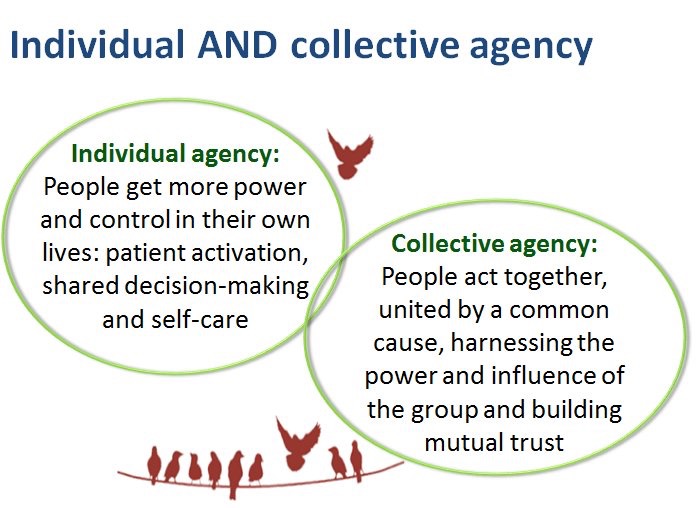 Of course, there are thresholds, and public safety also requires appropriate policing and collaborative working between communities, police and other helping agencies, indeed a central part of effective visioning and planning is figuring out those thresholds, by firstly asking what is that we can do using community power alone; secondly what can be achieved through community power along with outside support, and lastly what do community want done for them.
Of course, there are thresholds, and public safety also requires appropriate policing and collaborative working between communities, police and other helping agencies, indeed a central part of effective visioning and planning is figuring out those thresholds, by firstly asking what is that we can do using community power alone; secondly what can be achieved through community power along with outside support, and lastly what do community want done for them.
Whether in the realm of public safety, health, social farming, or a myriad of other themes for social good it is heartening to see some institutions showing up at Neighbourhood level with a view to supporting collective agency through the reseeding of associational life. Here is the story of how Bristol City Council have learned to be facilitators along with key local partners in supporting people to group up and build shared power in six local neighbourhoods, as told by Terry Black.
ABCD in Action in Bristol, UK.
By Terry Black
For the last three years Bristol City Council and our partners have been using an Asset Based Community Development approach to our work. We have 6 community animators working for the council based in eleven neighbourhoods across the city. We are working with citizens and partners focussing on how we can connect people around their interests, skills and passions to build associational life. Associational life offers a vital foundation in building stronger self-determining neighbourhoods.
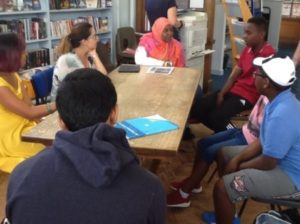 In Sea Mills through our community building conversations we met a few residents who said they wanted to support young people who might be struggling with their GCSE’s in particular around Maths and Science and acknowledged that many families in their neighbourhood wouldn’t be able to afford additional support. They wanted to offer something back to their community and to make a difference in a young person’s life. The residents met each other for the first time and now hold a monthly drop in session which 9 young people have so far benefitted from.
In Sea Mills through our community building conversations we met a few residents who said they wanted to support young people who might be struggling with their GCSE’s in particular around Maths and Science and acknowledged that many families in their neighbourhood wouldn’t be able to afford additional support. They wanted to offer something back to their community and to make a difference in a young person’s life. The residents met each other for the first time and now hold a monthly drop in session which 9 young people have so far benefitted from.
Doretta Caramaschi said “I often heard families struggling with their children’s homework and I wanted to help. The day of the Home support group is my favourite and I always look forward to it. The kids are amazing and with a little extra individual attention they get to where they want to with their school work, which is the most rewarding aspect. Being able to set up this group has boosted my confidence and gives me an opportunity to fulfil my goals of helping the community using my skills and to achieve what I believe in.”
We have been working alongside a men’s group in one of our neighbourhoods to grow their confidence so they feel able to do things together and take the lead on matters which concern them. One of the men, who would always welcome people in and help cook the bacon butties had a stroke. It was a difficult time for him and he felt really low. When he returned from hospital everyday men from the group came to visit him, check that he was alright and help him with whatever he needed. They aided his recovery, welcomed him back into the neighbourhood and made sure he was OK, now he is back contributing to the group. The men weren’t asked to support him but felt it was the right thing to do and offered more than what any worker or service could offer.
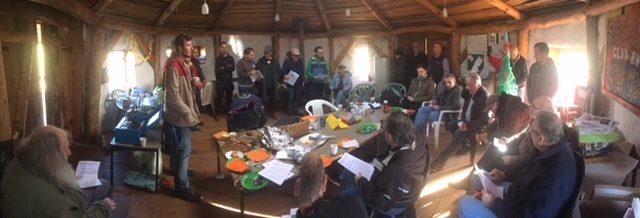 Rob who also goes the men’s group reflected on his experiences and said “My wife passed away last year and I didn’t know what to do, I was at an end. I didn’t want to bother anymore, I had had enough. I met a friend, a good friend who turned out to be a really good friend, and he asked me to come over to men’s group and start doing things. All I can say is that it has given me something to live for. This has changed my life.”
Rob who also goes the men’s group reflected on his experiences and said “My wife passed away last year and I didn’t know what to do, I was at an end. I didn’t want to bother anymore, I had had enough. I met a friend, a good friend who turned out to be a really good friend, and he asked me to come over to men’s group and start doing things. All I can say is that it has given me something to live for. This has changed my life.”
I’m glad Cormac mentioned the church choir because it links nicely to a community singing group that has emerged in Lockleaze. It is more than a singing group, its helping people get to know their neighbours, building trusting relationships and creating a sense of belonging to their neighbourhood.
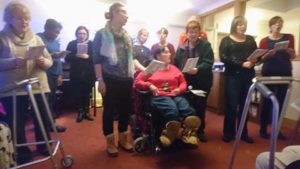 Angela said “I moved to Lockleaze 5 years ago and didn’t really feel part of the community given the hours I worked. I now feel part of this community and have met some lovely people who like me, enjoy our impromptu renditions of songs being sung in a variety of keys with much laughter, singing for wellbeing, no talent required is exactly what it says on the tin.”
Angela said “I moved to Lockleaze 5 years ago and didn’t really feel part of the community given the hours I worked. I now feel part of this community and have met some lovely people who like me, enjoy our impromptu renditions of songs being sung in a variety of keys with much laughter, singing for wellbeing, no talent required is exactly what it says on the tin.”
Over the last three years lots of people had expressed an interest in a singing group but nobody wanted to establish one. Our community animator didn’t want to do it for people, although it felt frustrating at times they waited patiently for the right moment to happen and it did when Rachel, Maria and Angela were introduced together. Supported by St Marys Church with a free venue the group met for the first time last July. At the first session 3 people came and by September the group had grown to 40+.
Maria said “As I’ve got older I don’t socialise as much and was looking for something fun and affordable to do which didn’t involve drinking or traveling too far. I started to ask around and was pleasantly surprised to find other people were enthusiastic about setting up a local singing group. I’ve met some great people, performed in public and rediscovered that doing something fun really does make you feel good.”
Associational life offers so much more than what we can offer as service providers and workers. It’s not delivered at certain times of the day and comes from a place of mutuality, trust and friendship. Some of our neighbourhoods have become more fragmented than others and need support to build connections and remove any barriers so associational life can flourish.
Laying the Groundwork for visioning and planning
Touchstone six while noting that many communities do create their own visions, also recognises that those visions are weaved together the work of local residents and supportive practitioners who are seeking to proliferate collective agency. That is what we see happening in Bristol, the groundwork for shared vision is being laid, civic muscle (collective efficacy) is being built. And it is that carrying capacity that will enable people to move forward together and cope when things become turbulent and sometimes break apart. A way of picturing how a community of associations limber up to creating a shared vision is imagine that what is happening is akin to all the various formal and informal groups ‘giving each other a good listen to’. Here’s a topology of the formal and informal associations you’re likely to encounter in a living community of place:
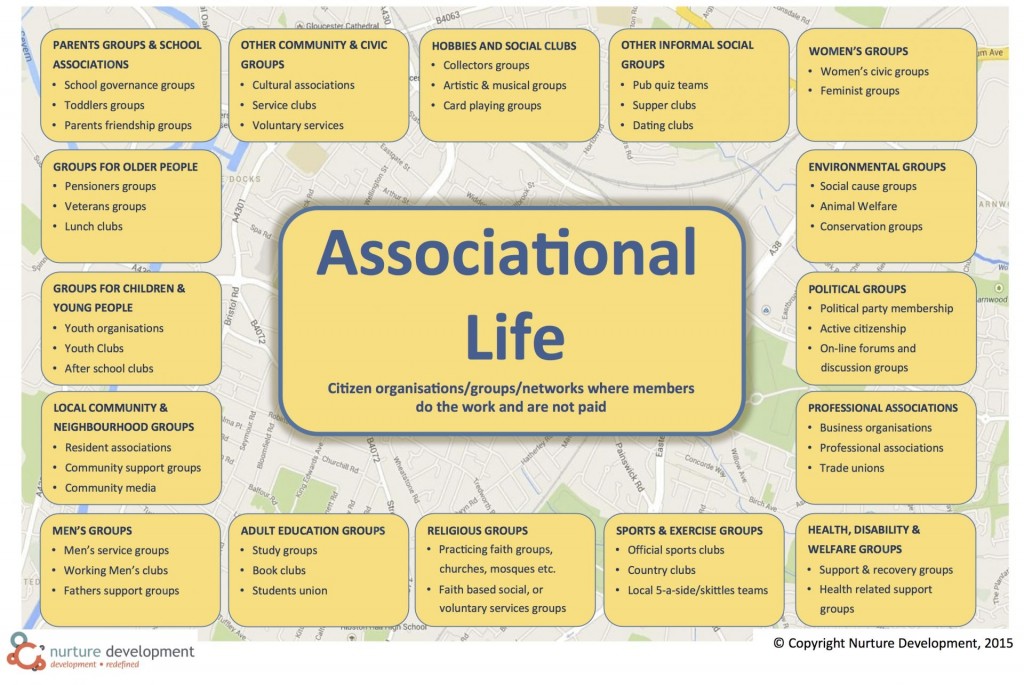
So imagine if they were helped to come together and grow the collective power to dream, do the dream, collaborate where needed and have powerful voice around what they wanted done for their community, what you would be imagining is an association of associations, or simply community power.
Associations amplify citizen power
Associations are understood here as citizen based groups where they “member up” to do the work of citizens and are not paid to do so, since the work is priceless and covenantal, not contractual. Of course some associations may have one employee, a pastor for example or a community animator, but the members (citizens) are the ones defining the challenges/possibilities. They too are choosing how best to respond to those challenges/possibilities. Moreover, they are taking action to implement agreed solutions.
‘Association’ is therefore the plural of ‘citizen’. As you have a flock of birds, you have an association of citizens. A church choir for example is an association of singers, together (like all associations) they amplify and multiply the singular capacity of each member, and the whole is greater than the sum of its parts. After all, no matter how good a singer you may be, you will never be a choir unto yourself.
Associations are the engine room of community powered change, it is from here that mutuality grows, and care finds cultural expression. As I learn with communities around the world I grow ever more convinced that anything that is beautiful, useful and durable is hatched out of the shared nest of individual and associational assets. Hence all sustainable change, and the visions and plans that precedes it, come from inside out. Or as Jim Kwik so aptly notes:
“If an egg is broken by outside force, Life ends. If broken by inside force, Life begins. Great things always begin from inside”.
The inside out force he is referring to is collective agency. It is this force that creates a good life, a deep democracy and sustainable economic and ecological future. Hatching such a future requires, deep connections, a gestation period, and a nest, hence the importance of all the other touchstones, and the willingness to travel at the speed of trust.
Cormac Russell
1 Sampson Robert J. Collective Efficacy Theory: Lessons Learned and Directions for Future Inquiry. In: Cullen FT, Wright JP, Blevins KR, editors. Taking Stock: he Status of Criminological Theory. New Brunswick: Transaction; 2006. pp. 149–167.
Click here for the complete series: The Eight Touchstones of Community Building
